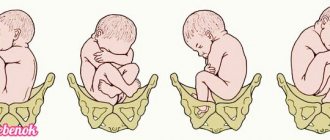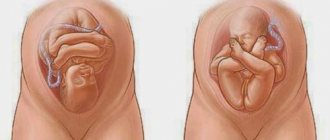The characteristics and tactics of labor depend on the course of pregnancy. One of the important meanings is the position of the fetus in the womb. It is by taking into account how the unborn child is located in the uterus that the type of delivery is determined: naturally or by cesarean section.
Often during pregnancy, transverse presentation of the fetus in the womb is diagnosed based on the results of ultrasound analysis. In this case, is it possible to give birth on your own without resorting to surgery?
Presentation - the position of the baby in the womb of a pregnant woman is the ratio of its axis passing through the head and buttocks, and the longitudinal axis of the uterus. A distinction is made between longitudinal presentation, when the axis of the child and the organ in which it is located coincides, and transverse presentation, when the fetus is perpendicular to the axis of the uterus. There is also a third type of presentation - oblique - something between transverse and longitudinal.
What is the transverse position of the fetus?
If there are no pathologies on the part of the mother or baby, after 34 weeks the child takes a position with his head down towards the cervix, that is, towards the exit. This presentation is considered physiologically correct and convenient for labor.
In some cases, when exposed to provoking factors, the child takes a different position, turning towards the exit with his legs, buttocks, or positioned perpendicular to the cervix.
The transverse position of the baby at 20-32, even up to 34 weeks, is unstable and can still change. However, after 34 weeks, the fetus becomes in the position that remains until labor. If after this time, according to the results of an ultrasound examination, a transverse or oblique position of the fetus is diagnosed, a planned cesarean section at the time of delivery is called into question.
Causes
Most often, babies find themselves in a transverse position, as they can easily and freely move in the uterus even at long periods of time. Polyhydramnios promotes such physical activity. If the amount of amniotic fluid is higher than normal, then the baby may well take this position and “get stuck” in it. Also, active movements over long periods are facilitated by weak and overstretched uterine walls. Weakness and some flabbiness of smooth muscles is characteristic of women who give birth a lot and often.
As strange as it may sound, the transverse position is also facilitated by low motor activity, or rather, the inability for the child to move. This condition is characteristic of oligohydramnios. Large, hypertrophied children also experience difficulties with movements and rollovers.
A woman with a multiple pregnancy has a risk of transverse presentation of one of the children or both at once, which is why the position and condition of each of the fetuses is monitored so carefully throughout the entire multiple pregnancy.
The baby can take a transverse position as the only comfortable one if a woman almost constantly has increased uterine tone throughout pregnancy, and there are tumors or other neoplasms in the lower uterine segment. The establishment of a normal cephalic presentation therefore becomes unacceptable for the child. In addition, transverse or oblique presentation is often observed during pregnancy in women with congenital abnormalities of the main reproductive organ - a saddle-shaped or bicornuate uterus.
Quite often, the placenta interferes with the baby if it is located low; there is a complete or partial presentation of it. When the entrance to the small pelvis is blocked by something, the baby cannot get into the correct position - cephalic presentation. A child in a woman with a clinically narrow pelvis can also be located across the womb.
Sometimes the reason for the malposition of the child lies not in maternal factors, but in the child himself. So, with hydrocephalus (water on the brain) or anencephaly (absence of the brain), the baby does not assume a head position, but remains either sitting in a breech position or lying across the uterine cavity.
Why does the baby lie transversely in the stomach?
The list of reasons for the transverse presentation of a baby in the womb is quite large. The main provoking factors include:
- polyhydramnios , due to which there is active movement of the baby in the uterus;
- weakness of the muscular elements of the uterus , which is more often observed in second and subsequent pregnancies, and the uterus is no longer able to fix the fetus in one position;
- fibroids in the uterus (in this case, the child takes an advantageous position so as not to touch the neoplasms with his head, which prevent him from moving);
- structural anomalies of the female organ , in which the fetus seeks the most comfortable position for itself, which in most cases turns out to be transverse;
- premature birth , when the child did not have time to take a physiological presentation due to the early discharge of amniotic fluid;
- multiple pregnancy (several fetuses are cramped in the womb, so one of them may take the wrong position).
In addition, the reasons include increased muscle tone of the uterus, threat of miscarriage, narrow maternal pelvis, and anterior abdominal location of the placenta.
Leading a sedentary lifestyle by a pregnant woman is an equally significant factor that can affect transverse presentation. If a pregnant woman is constantly in monotonous positions, starting from the 30th week, the baby in the womb may simply “get stuck” in the wrong position.
Breech and transverse presentation are often diagnosed in women who have suffered severe emotional shock and in those who have abused physical activity.
The reason may be the short length of the umbilical cord and the low location of the placenta, and for the child the transverse position will be as comfortable as possible.
Causes of pathological presentation
- Myoma
Large nodes can deform the uterine cavity. If the fibroid is located subserosally and grows predominantly into the abdominal cavity, it poses less of a danger than a submucosal or interstitial node. The last two can significantly change the size of the uterine cavity.
It should also be remembered that women with small nodes that were stable before pregnancy may experience accelerated growth after conception. This is due to an increase in progesterone and a large number of receptors for it on myomatous nodes. The child, in an attempt to take a comfortable position, will bump into a protruding dense knot and will not be able to turn his head down.
- High birth parity
The reasons for the transverse position of the fetus may lie in multiple births. This condition is much less common in primiparous women, but the frequency increases with 4-5 births. The increase in risk is explained by a decrease in the tone of the abdominal muscles, more flabby tissues capable of significant stretching.
- Congenital defects of the uterus
- Low water
If the amount of amniotic fluid is insufficient, the situation is the opposite. The baby cannot take the correct position due to limited space in the uterine cavity.
- Polyhydramnios
A large amount of amniotic fluid stretches the uterus, allowing the fetus to float freely in its cavity and change location. occurs due to infection, fetal pathology, and is combined with intrauterine hypoxia. At the same time, the child’s motor activity increases, the woman hears active movements, and the likelihood of a transverse or oblique position increases.
- Threat of premature birth
With constant or frequently recurring tone of the uterus, the child experiences pressure from its walls. They do not allow him to move to the required position. Therefore, transverse or oblique presentation may not change to the correct one by the required time.
- Fetal hypotrophy
Feto-placental insufficiency leads to chronic. This affects the child’s weight: there is a delay in gaining length and body weight, sometimes by several weeks. Lack of weight allows free movement in the uterine cavity and by the time of birth may remain incorrectly positioned relative to the axis.
- Large fruit
The risk increases in the presence of a narrow pelvis of 1-2 degrees. The child does not have enough room to move, he cannot lower himself into the small pelvis, so he takes the wrong position.
- Multiple pregnancy
With twins, one or both children may take a position that is most comfortable for them, but makes it difficult to give birth naturally. Sometimes the first baby is positioned correctly, and the second one lies across, forming a kind of belt around him. Natural childbirth in this case is impossible; it will lead to neglected transverse position and fetal death.
Sometimes a transverse position is observed during premature birth, which occurs at 28-29 weeks and up to 37 weeks. Adnexal tumors located above the pelvic inlet are also a risk factor.
Symptoms and diagnosis
There are no specific symptoms of transverse presentation.
However, in some cases, a pregnant woman notices that the stomach has acquired an unnatural shape and has increased in width. Only a doctor can make an accurate diagnosis based on the diagnostic results. An obstetric examination of a pregnant woman involves palpation of the abdomen. In this case, it is impossible to determine the presenting part of the child, whether the head is located to the right or left of the middle of the woman’s abdomen, and not along its axis, as it should be. The baby's heartbeat can be heard in the pregnant woman's navel area.
A vaginal examination after the water breaks and the cervix is dilated by 4-5 cm confirms the transverse location: the shoulder, scapula, rib, elbow or hand of the fetus are identified near the uterine pharynx.
Negative consequences in different weeks
As a rule, pregnancy with a transverse presentation of the child proceeds without pathological changes. Closer to the date of labor, premature rupture of amniotic fluid may occur. Against the backdrop of the latter process, the risk of a part of the fetal body being driven into the pelvis of the expectant mother, prolapse of the arm or umbilical cord increases, which is explained by a sharp limitation of mobility.
When part of the child’s body falls out, the fetus is in advanced transverse presentation; if a caesarean section is not started immediately, the risk of intrauterine death increases. If the case is advanced and labor progresses, the uterus may rupture.
In addition, sepsis, diffuse peritonitis, chorioamnionitis often develop, and with an anhydrous interval lasting 12 hours or more, acute hypoxia or asphyxia of the fetus occurs.
In rare cases, during labor, the child spontaneously turns into a physiological position. Sometimes a reversal into a cephalic or pelvic presentation is observed, which is caused by strong contractions and extreme prematurity.
Childbirth with a diagnosed transverse presentation of the fetus
Until 34-35 weeks of pregnancy, the oblique or transverse position is considered unstable, as it can change to the correct one. If such a pathology is detected, it is necessary to carefully examine the pregnant woman and determine the cause of the anomaly, choose the tactics for managing the woman and the method of delivery.
Usually, at 30-34 weeks of pregnancy, special gymnastics is prescribed, which will help the baby turn around.
Contraindications to corrective gymnastics:
- Threat of miscarriage;
- Scar on the uterus;
- Myoma;
- Decompensated heart defects in the expectant mother;
- Bloody discharge, etc.
Approximately 4-5 weeks before birth, the baby takes a stable position, therefore, if the pathological condition persists, the woman is hospitalized to determine delivery tactics.
Previously, they resorted to external rotation onto the head, but now this is rare, since this method is ineffective and can lead to placental abruption, uterine rupture, and fetal hypoxia.
The optimal method for bringing a baby into the world under such circumstances is a caesarean section. Indications for the latter are: placenta previa, premature rupture of water, uterine scar, oxygen deficiency in the baby, post-term pregnancy. If parts of the fetal body fall out, their reduction is unacceptable.
When the uterus is dilated by 10 fingers and the baby is alive and mobile, it is possible to turn it onto its leg and further extract it. However, such manipulations and natural childbirth can only be carried out in cases of multiple births and prematurity.
If there was a long anhydrous interval, and later an infection joined it, then after surgical delivery the woman undergoes hysterectomy, and there is also a need for drainage of the abdominal cavity.
Position correction
If before the 34th week the conclusion was made “transverse presentation of the fetus,” you should not sound the alarm and worry, because before the end of this period everything can still change and the baby may turn into a position convenient for childbirth.
A woman is recommended to perform special gymnastics, which in 75-95% of cases helps the baby to take a presentation favorable for childbirth. However, contraindications that act as an obstacle to performing exercise therapy should also be taken into account. This is the presence of a tumor-like neoplasm in the uterus, severe gestosis, etc. If it is possible to achieve the physiological location of the fetus, it is recommended to start wearing a bandage for fastening.
Exercises useful for transverse fetal position:
- before eating, lie on a hard surface on the right and left sides for 10 minutes (starting from 31 weeks of pregnancy);
- lie on your back with a cushion of clothing under your feet so that your limbs are 20-30 cm above your head, while your pelvis should be slightly elevated (15 minutes three times a day);
- sleep on the side where the fetal head is located;
- three times a day, take a pose, kneeling, leaning on your elbows for 15 minutes;
- Swimming will be useful.
Only an obstetrician-gynecologist can determine whether it is possible to have sex with the fetus in a transverse position. In most cases, if there are no other warning signs, a ban on sexual relations is not imposed.
How does childbirth go?
Of course, transverse presentation of the fetus in the womb causes a great risk for the woman herself and her unborn child; if it has not turned into a physiological position before the moment of labor, independent childbirth is excluded due to the possibility of developing complications.
Natural delivery is permitted in cases of low fetal weight or premature birth. However, at such moments the level of cervical dilatation is taken into account. If it does not happen enough, even with a small weight of the child, a caesarean section will be required.
Already at 36-37 weeks, a woman needs to go to the maternity ward and begin preparing for surgery. If with an oblique presentation there is still a possibility of the child turning around, then with a transverse position the chances are reduced to a minimum.
The planned operation is performed on an empty stomach. Before the intervention, the woman needs to empty her bowels and bladder. If this cannot be done naturally, an enema is given. Next, anesthesia is administered and a caesarean section begins.
Medical errors and methods for preventing them
Oblique presentation of the fetus contributes to the death of the child due to a common medical error as defined by a dropped arm. It is confused with a leg, which completely changes the clinical picture. During the birthing process, you have to act quickly. To prevent medical error, you can focus on the following signs:
- the first finger of the handle can be pressed to the palm, but on a leg it is impossible to press the first finger to the foot;
- There is a calcaneal tubercle on the foot, but not on the hand.
These signs will allow you to quickly distinguish the handle from the leg. Clinical practice suggests that obstetricians sometimes do not distinguish between the right and left arms, and yet this is important, because the entire position of the fetus is determined from landmarks on the arm. In an emergency situation, it is useful to use this method: mentally shake hands with the fetus. If it works, use the right handle; if this is impossible, use the left handle. How to protect yourself from medical errors from a mother’s perspective? Modern clinics provide the opportunity for the father to be present during childbirth and video recording of this memorable event.
If such an opportunity exists, it is worth taking advantage of it in order to have a chronicle of events. This will provide sufficient grounds for appealing to the courts.









